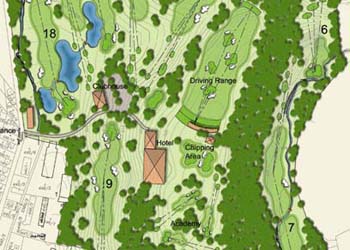Teeing Off: How Many Acres Do You Need to Build a Golf Course?
Building a golf course requires careful planning and consideration of various factors. The size of the golf course, its layout, and the facilities and amenities offered play a significant role in determining the land area needed. However, each type of golf course has specific requirements. A regulation golf course, which is the standard-sized course, requires more land compared to an executive or par-3 golf course.

Factors to Consider:
- Golf Course Size: The size of the golf course, including the number of holes, fairways, and greens, influences the land area required.
- Golf Course Layout: The layout of the course, including water features, bunkers, and hazards, impacts the overall land area needed.
- Facilities and Amenities: Consideration should be given to additional facilities such as a clubhouse, parking area, practice range, and other amenities that enhance the golfing experience.
Recommended Land Area for a Golf Course:
- Regulation Golf Course: A regulation golf course commonly consists of 18 holes and requires a larger land area, typically ranging from 100-200 acres or more.
- Executive Golf Course: An executive golf course is smaller and typically features 9 holes. It requires a land area ranging from 30-100 acres.
- Par-3 Golf Course: A par-3 golf course is the smallest in size, generally featuring 9 holes. It requires a land area ranging from 10-30 acres.
Challenges and Considerations:
- Land Cost: The cost of acquiring land suitable for a golf course can be a significant factor to consider in determining the overall feasibility of the project.
- Maintenance and Upkeep: Proper maintenance of a golf course requires dedicated resources and ongoing expenses for landscape upkeep, irrigation, and equipment maintenance.
- Environmental Impact: Building a golf course can have environmental implications, including land disruption, water usage, and potential impact on local ecosystems. Environmentally sustainable practices should be implemented to minimize the impact.
When considering building a golf course, it is crucial to evaluate these factors, assess the land requirements based on the type of golf course desired, and carefully navigate the potential challenges associated with the project.
Useful links:
Factors to Consider
When it comes to planning a golf course, there are several key factors to consider that can greatly impact its success. From the size of the course and its layout to the facilities and amenities available, each element plays a crucial role in creating a memorable golfing experience. In this section, we will explore these factors in detail, diving into the importance of golf course size, the impact of the layout on gameplay, and the significance of well-designed facilities and amenities. So, let’s tee off and explore what it takes to create a truly exceptional golf course.

Golf Course Size
|
Golf Course Size |
|
Golf Course Size is a vital consideration in the development of a golf course. |
|
A golf course requires a significant amount of land to accommodate the various holes, fairways, greens, and other features. |
|
The Golf Course Size can vary depending on the type and purpose of the course. |
|
For a regulation golf course, the recommended land area is typically between 125 and 150 acres. |
|
This Golf Course Size allows for the standard 18 holes, as well as space for driving ranges, practice areas, and other facilities. |
|
Executive golf courses, which are smaller and typically have fewer holes, require less land. An executive course can be built on as little as 60 acres. |
|
A par-3 golf course, designed for shorter games, can be even smaller, typically ranging from 30 to 40 acres. |
|
When determining the Golf Course Size, it is important to consider the desired playing experience and the terrain of the land. |
|
Some golf courses may be designed to take advantage of the existing natural features, such as hills or water bodies, which may require additional land. |
|
It is also important to leave space for maintenance and landscaping, as well as future expansion if desired. |
Golf Course Size is a vital consideration in the development of a golf course. The size of the course directly affects aspects such as the number of holes, the layout, and the range of facilities that can be included. Here is some essential information to keep in mind:
1. Regulation Golf Course: A standard regulation golf course typically requires a land area between 125 and 150 acres. This allows for the standard 18 holes, along with practice areas, driving ranges, and other necessary facilities.
2. Executive Golf Course: For a smaller executive golf course, the required land area can be as little as 60 acres. Executive courses usually have fewer holes and are designed for a shorter game.
3. Par-3 Golf Course: A par-3 golf course, which focuses on shorter games, can be even smaller. These courses typically range from 30 to 40 acres in size.
When determining the size of a golf course, factors such as the desired playing experience and the natural features of the land should be considered. The layout of the course may take advantage of existing hills, water bodies, or other terrain elements, which could impact the required land area.
Additionally, it’s crucial to allocate space for maintenance and landscaping needs, as well as potential future expansions. By considering these factors, developers can ensure that the golf course size aligns with their goals and provides an optimal experience for golfers.
Get ready to navigate a maze of bunkers, water hazards, and snaking fairways in this exhilarating game of human golf.
Golf Course Layout
The layout of a golf course plays a crucial role in providing an enjoyable and challenging experience for golfers. A well-designed layout not only enhances the aesthetics of the Golf Course Layout but also affects the strategic elements and flow of play.

A Golf Course Layout that balances challenge, strategy, and playability will ensure an enjoyable experience for both beginners and seasoned golfers. It is important for golf course architects and designers to carefully plan and implement these elements to create a Golf Course Layout that provides a fair and rewarding game for all players.
With top-notch facilities and amenities, golfers can enjoy a round of golf and indulge in luxurious pampering – because why settle for just a great swing when you can also have a great spa treatment?
Facilities and Amenities
When it comes to choosing a golf course, the facilities and amenities available play a crucial role in enhancing the golfing experience. Here are some key factors to consider:
- Clubhouse: A well-equipped clubhouse offers a variety of amenities such as locker rooms, pro shops, and dining options.
- Practice Facilities: Look for golf courses that have adequate practice facilities and amenities, including driving ranges, putting greens, and chipping areas. These allow you to warm up and improve your skills before hitting the course.
- Cart and Equipment Rental: Check if the golf course offers golf cart rentals and equipment for those who prefer not to bring their own. This can make the game more accessible and convenient.
- On-Course Amenities: Consider whether the course provides facilities and amenities like refreshment stations, on-course restrooms, and GPS systems on golf carts for easy navigation.
- Dining Options: Having dining options on-site allows you to enjoy a meal or refreshments before or after your round of golf. Some courses even have upscale restaurants, snack bars, or beverage carts on the course.
- Event Spaces: If you plan on hosting events or tournaments, check if the golf course has event spaces available for rent. This can be convenient for corporate outings or special occasions.
- Proximity to Accommodations: It can be beneficial to choose a golf course that is near accommodation options if you’re planning an extended stay. This way, you’ll have easy access to the course and other facilities and amenities.
Considering these facilities and amenities can greatly enhance your overall golfing experience. Whether it’s the convenience of having a well-stocked pro shop or the pleasure of enjoying a celebratory meal after a round, these factors contribute to a more enjoyable and convenient golfing experience.
Recommended Land Area for a Golf Course
When it comes to building a golf course, the land area plays a crucial role. So, how much space do you actually need? Let’s dive into the recommended land area for different types of golf courses. From regulation courses to executive and par-3 layouts, each sub-section will unveil the space requirements and unique features. We’ll also touch upon the importance of maintenance, upkeep, and environmental impact, giving you a comprehensive understanding of what it takes to create a successful golfing haven.
Regulation Golf Course
A regulation golf course is a standard golf course that meets specific criteria set by governing bodies such as the United States Golf Association (USGA) or the Royal and Ancient Golf Club of St. Andrews (R&A).
- Course length: A regulation golf course typically has a total length of around 6,000 to 7,000 yards for men’s courses and 5,000 to 6,000 yards for women’s courses. These lengths ensure a challenging yet enjoyable playing experience.
- Number of holes: A regulation golf course consists of 18 holes. This is the standard number of holes for tournament play and provides a comprehensive golfing experience.
- Hole design: The holes on a regulation golf course are strategically designed with a mix of par 3, par 4, and par 5 holes. Par 3 holes are shorter and usually require just one shot to reach the green. Par 4 holes are of medium length and typically require two shots to reach the green. Par 5 holes are the longest and usually require three shots to reach the green.
- Golf course layout: A regulation golf course is laid out in a way that offers a variety of challenges and shot options. It includes fairways, roughs, bunkers, water hazards, and out-of-bounds areas. The placement of these elements requires players to strategically navigate the course.
- Golf course rating and slope: Each regulation golf course is assigned a course rating and slope rating. The course rating represents the difficulty of the course for a scratch golfer, while the slope rating indicates the difficulty for an average player. This allows players to compare and evaluate the challenge of different regulation golf courses.
When choosing to play on a regulation golf course, consider your skill level, the challenge you seek, and the overall golfing experience you desire. If you are an advanced golfer looking for a competitive round, a regulation golf course would be an ideal choice. However, if you are a beginner or prefer to play a shorter round, you may want to consider an executive or par-3 golf course.
Remember, playing on a regulation golf course requires adherence to golf etiquette, respect for the rules of the game, and consideration for other golfers. Enjoy the challenge, improve your skills, and savor the beauty of the course as you make your way to the final hole.
Don’t be fooled by the fancy title, an executive golf course is just a shorter version of normal golf for people with commitment issues.
Executive Golf Course
An executive golf course is a type of golf course that is smaller in size and typically designed for golfers who want a quicker and more relaxed game. Here are some key points to consider when it comes to executive golf courses:
- Size: Executive golf courses are generally smaller compared to regulation golf courses. They typically range from 3,000 to 5,000 yards in total length, with 9 holes instead of the traditional 18 holes.
- Layout: The layout of an executive golf course is designed to provide a variety of challenges and opportunities for players. Despite the smaller size, these courses can still offer a mix of par 3s, par 4s, and even a few par 5s.
- Time and Accessibility: One of the main advantages of executive golf courses is that they can be played in a shorter amount of time compared to regulation courses. This makes them a popular choice for golfers who have limited time or prefer a quicker round. Additionally, executive courses are often more accessible in terms of membership fees and availability.
- Skill Level: While executive courses offer a more relaxed gameplay, they still require skill and strategy. These courses can be enjoyed by golfers of all skill levels, from beginners looking to improve their game to experienced players who want to sharpen their short game.
- Experience: Playing on an executive golf course provides a different experience compared to a regulation course. The smaller size allows for a more intimate and leisurely atmosphere, with a focus on precision and accuracy rather than long shots.
When considering an executive golf course, it is important to assess your preferences, time constraints, and skill level. If you enjoy a shorter game and a more relaxed environment, an executive golf course may be the perfect fit for you. Whether you are a beginner or an experienced golfer, these courses offer a unique and enjoyable golfing experience.
Par-3 Golf Course
A par-3 golf course, also known as a short-scale golf course, is specifically designed to have shorter holes compared to a standard golf course. These courses cater to beginners by providing a friendly atmosphere and allowing players to practice their short game skills. Here are the key aspects to consider when it comes to par-3 golf courses:
- Accessibility: Par-3 golf courses are suitable for players of all ages and skill levels. They welcome beginners who are learning the game and provide a relaxed experience for experienced golfers focusing on their short game.
- Hole Length: Par-3 golf courses typically feature holes that range from 100 to 200 yards in length. This shorter distance allows players to reach the green in one or two shots, boosting their confidence and providing a sense of accomplishment.
- Practice Opportunities: Par-3 courses are perfect for practicing various aspects of the game, particularly the short game. With shorter holes, players can work on their pitching, chipping, and putting skills, which are crucial for success in golf.
- Time Efficiency: One of the major advantages of playing on a par-3 golf course is the speed of play. Due to the shorter hole lengths, rounds on these courses are faster, making it possible to enjoy a quick game during a lunch break or after work.
- Affordability: Par-3 golf courses often offer more affordable rates compared to full-scale golf courses. This makes them a budget-friendly option for individuals who want to play golf without spending a fortune.
- Family-Friendly: Par-3 courses are an excellent choice for a family outing or introducing children to golf. The shorter hole distances and relaxed atmosphere make it enjoyable for everyone, regardless of their age or experience level.
A par-3 golf course provides the perfect setting for golfers to improve their skills, enjoy a fast-paced round of golf, and create a welcoming environment for all players. Whether you are a beginner learning the game or an experienced golfer looking to enhance your short game, a par-3 golf course offers a fantastic opportunity to enjoy the sport.
When it comes to maintenance and upkeep, remember that a golf course can turn into a grassy money pit if not managed properly.
Maintenance and Upkeep
Maintenance and upkeep are crucial aspects of managing a golf course to ensure its optimal performance and player satisfaction. Here are some key factors to consider when it comes to maintenance and upkeep:
- Budget allocation: Adequate funds must be allocated for regular maintenance and upkeep activities. This includes the cost of hiring skilled staff, purchasing equipment, and acquiring necessary materials.
- Turf care: The maintenance of turf is of utmost importance. Regular mowing, aerating, and fertilizing the greens, fairways, and roughs are necessary to maintain their health and aesthetics. Uneven or poorly maintained turf can negatively impact the playability of the course.
- Irrigation: Proper water management is essential to keep the course green and healthy. An efficient irrigation system with appropriate sprinkler placement and scheduling can ensure that the turf receives the right amount of moisture without wasting water.
- Pest and weed control: Regular monitoring and implementing integrated pest management techniques are necessary to control pests and weeds that can damage the turf. This includes the use of environmentally friendly pest and weed control methods to minimize the impact on the ecosystem.
- Greenkeeping equipment: Investing in high-quality maintenance equipment such as mowers, sprayers, and tractors is essential to efficiently manage the course. Regular maintenance and servicing of the equipment are crucial to ensure their longevity and optimal performance.
- Bunker maintenance: Bunkers are a vital part of a golf course and require regular attention. Regular raking, removal of debris, and monitoring sand quality are necessary to provide consistent playability and prevent erosion.
- Course aesthetics: Regular maintenance tasks like trimming trees, planting flowers, cleaning water features, and ensuring proper signage enhance the overall aesthetics of the course. Well-maintained surroundings contribute to a positive playing experience for golfers.
- Environmental considerations: Implementing sustainable practices, such as water conservation measures, use of eco-friendly products, and protection of natural habitats, should be prioritized during maintenance and upkeep activities to minimize the environmental impact of the golf course.
Effective maintenance and upkeep of a golf course are integral to create an enjoyable and well-presented playing environment. It is crucial to establish a comprehensive maintenance plan and regularly assess its effectiveness through player feedback and monitoring of course conditions. By prioritizing these maintenance and upkeep factors, golf course owners and managers can ensure the longevity and success of their courses.
Environmental Impact
The environmental impact of a golf course can have significant effects and should be carefully considered when designing and managing a golf course. Here are some crucial factors to take into account:
- Water usage: Golf courses require large amounts of water for irrigation. They often utilize treated wastewater or groundwater sources, which can have harmful impacts on local water supplies. It is vital to implement water conservation practices and use drought-resistant grass varieties to minimize water usage.
- Chemical usage: Golf courses often rely on pesticides, fertilizers, and herbicides to maintain the quality of the course. These chemicals can seep into the soil and contaminate groundwater, negatively affecting local ecosystems. Implementing integrated pest management techniques and using organic and environmentally-friendly products can help reduce the environmental impact.
- Habitat destruction: Clearing land for a golf course can lead to the destruction of natural habitats and loss of biodiversity. It is crucial to conduct thorough environmental assessments and incorporate measures to protect and enhance local ecosystems. This can involve preserving wetlands, planting native vegetation, and creating wildlife corridors.
- Erosion and sedimentation: Golf course construction and maintenance practices can contribute to erosion and sedimentation, especially in areas with hilly terrain or inadequate stormwater management. Implementing erosion control measures such as contouring, vegetative buffers, and sediment basins can help minimize the impact.
- Energy consumption: Maintaining a golf course requires significant energy inputs for irrigation, lighting, and maintenance equipment. Using energy-efficient technologies, such as smart irrigation systems and LED lighting, can help reduce energy consumption and the associated environmental impact.
- Waste management: Golf courses generate large amounts of waste, including grass clippings, tree trimmings, and golf course maintenance debris. Implementing recycling and composting programs, as well as proper hazardous waste disposal for chemicals, can help minimize the environmental impact of waste generation.
By considering and addressing these environmental impact factors, golf course operators can create and maintain courses that are more sustainable and environmentally-friendly.
Some Facts About How Many Acres You Need for a Golf Course:
- ✅ The average size of a standard 18-hole golf course is between 120 and 200 acres. (Source: pitchmarks.com)
- ✅ Championship and stadium golf courses often require over 200 acres of land. (Source: pitchmarks.com)
- ✅ A 9-hole golf course typically needs between 60 and 100 acres. (Source: pitchmarks.com)
- ✅ An 18-hole par 3 golf course can be built with as little as 30 acres of land. (Source: pitchmarks.com)
- ✅ Some world-class golf courses can measure upwards of around 200 acres per 18 holes. (Source: sunsetbaygolf.com)
Frequently Asked Questions
How many acres is the average size of a golf course?
The average size of a golf course is typically around 160 acres, including space for a practice area and clubhouse. However, the size can range from 120 to 200 acres depending on various factors.
What is the size of an executive golf course?
Executive golf courses are smaller, usually in the range of 80-100 acres, and often have a par of 36 instead of 72.
How large is a 9-hole golf course?
A 9-hole golf course is generally about half the size of an 18-hole course, so it would be around 80-100 acres.
What factors affect the size of a golf course?
Factors that affect the size of a golf course include the length of the course, level of difficulty, size of the practice range, size of the clubhouse, and design features like bodies of water. More complex designs require more acres, while plain courses can be smaller. Other minor factors can also influence the size of a golf course.
How many acres does a par 3 golf course require?
An 18-hole par 3 course can sit on as few as 30 acres, while a more relaxed layout with some par 4s would require about 75-100 acres. A 9-hole par 3 course can sit on 15-20 acres, depending on hole length and land usability.
What is the general acreage requirement for building a golf hole?
Building a single golf hole or a small loop of holes on one’s property can be accomplished with a relatively small amount of land, such as 1.5 acres for a par 3 hole or 10 acres for a typical par 4 hole.


![Golf Club Buying Guide: How Much to Spend for the Perfect Set [2024]](https://www.fairwayfindings.com/wp-content/uploads/2024/03/Golf-Club-Buying-Guide-768x768.webp)


